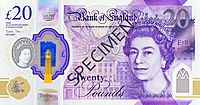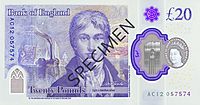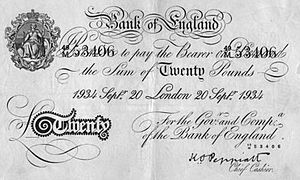Bank of England £20 note facts for kids
| (United Kingdom) | |
|---|---|
| Value | £20 sterling |
| Width | 139 mm |
| Height | 73 mm |
| Security features | See-through windows the larger one with a purple border and the Queen's portrait, blue and gold foil on the front, silver foil on the back in the shape of Margate lighthouse, smaller window at the bottom right corner, raised dots, finely detailed round purple metallic image containing the letter "T", blue and pink foil patch with a 3D image of the Coronation Crown, micro lettering, textured print, UV feature, hologram |
| Paper type | Polymer |
| Years of printing | 1725–1943; 1970–1991; 1991-2000; 1999-2007; 2007-2020; 2020–present (current design) |
| Obverse | |
 |
|
| Design | Queen Elizabeth II |
| Design date | 20 February 2020 |
| Reverse | |
 |
|
| Design | J. M. W. Turner |
| Design date | 20 February 2020 |
The Bank of England £20 note is a type of money used in the United Kingdom. It's a banknote, which means it's paper money, not coins. This £20 note is the second-biggest value banknote made by the Bank of England.
The newest version is made from plastic, called polymer. It came out on 20 February 2020. On one side, you'll see Queen Elizabeth II. On the other side is a famous painter named J. M. W. Turner. This new note replaced an older paper one. That old note had a picture of an economist, Adam Smith.
Contents
History of the £20 Note
Early Notes: From Handwritten to Printed
The Bank of England first made twenty pound notes in 1725. The very first notes were written by hand. They were given to people as they needed them. These notes were only written on one side. They showed the person's name, the date, and the cashier's signature.
For a long time, you could swap these notes for gold at the bank. This changed between 1797 and 1821. There wasn't enough gold because of wars. From 1853, printed notes took over from handwritten ones. These new notes had a promise: "I promise to pay the bearer on demand the sum of twenty pounds." This promise is still on Bank of England notes today.
Changes in Design and Security
Britain stopped swapping banknotes for gold in 1931. The Bank of England stopped making £20 notes in 1943. They didn't come back until 1970. These new notes were called "Series D." They were mostly purple and had pictures on both sides.
One side showed Queen Elizabeth II. The other side featured William Shakespeare. These notes also had a special security feature. A metal thread was woven into the paper. It looked like a dashed line. But if you held it to the light, it looked like one solid line.
Newer notes, called "Series E," came out in 1991. These were colourful, mainly purple. They had a picture of scientist Michael Faraday on the back. A different "Series E" note came out in 1999. This one had the composer Edward Elgar on the back.
The Paper £20 Note (2007-2020)
The most common paper £20 note came out in 2007. It had a picture of the Scottish economist Adam Smith on the back. It also showed workers in a pin factory. This note had many security features. These included raised print, a watermark, and tiny writing. There was also a holographic strip. A colourful pattern appeared only under ultraviolet light.
The New Polymer £20 Note (2020-Present)
In 2015, the Bank of England said the next £20 note would be plastic. This plastic is called polymer. In 2016, they announced that artist J. M. W. Turner would be on the new note. It started being used on 20 February 2020.
The Turner note has several images on the back. These include a self-portrait of Turner from around 1799. It also shows a version of his famous painting, The Fighting Temeraire. There's a quote from Turner: "Light is therefore colour." You can also see a copy of his signature.
Like all new plastic notes, the polymer £20 note has clear windows. These help stop people from making fake notes. It also has raised dots. These dots are like Braille. They help people who can't see well to identify the note.
Designs of the £20 Note Over Time
This table shows how the £20 note has changed over the years.
| Note Series | First Issued | Last Issued | No Longer Legal Tender | Colour | Size | Main Design | Interesting Facts |
|---|---|---|---|---|---|---|---|
| White | 1725 | 1943 | 16 April 1945 | Monochrome (one colour) |
211 × 133 mm (size varied) |
No specific design | Not made between 1945 and 1970. |
| Series D | 9 July 1970 | 1991 | 19 March 1993 | Mostly purple | 160 × 90 mm | Front: Queen Elizabeth II Back: William Shakespeare |
First £20 note with the Queen's picture. Had a "windowed" security thread from 1984. |
| Series E | 5 June 1991 | 2000 | 28 February 2001 | Many colours (mostly purple) | 149 × 80 mm | Front: Queen Elizabeth II Back: Michael Faraday |
Notes from 1993 had an extra £20 symbol. |
| Series E (variant) | 22 June 1999 | 2007 | 30 June 2010 | Front: Queen Elizabeth II Back: Edward Elgar |
|||
| Series F | 13 March 2007 | 2020 | 30 September 2022 | Front: Queen Elizabeth II Back: Adam Smith |
|||
| Series G | 20 February 2020 | 139 × 73 mm | Front: Queen Elizabeth II Back: J. M. W. Turner |
This is the current plastic (polymer) note. |
This information comes from the Bank of England website.
See also


